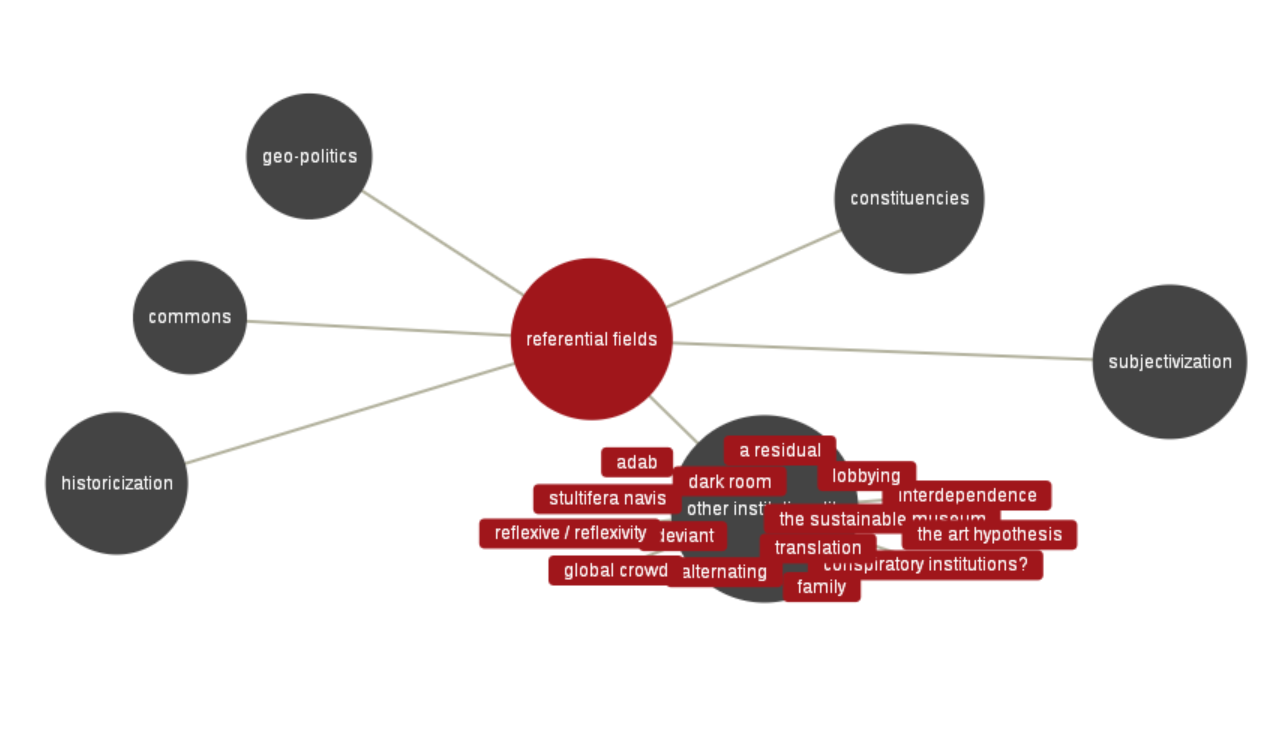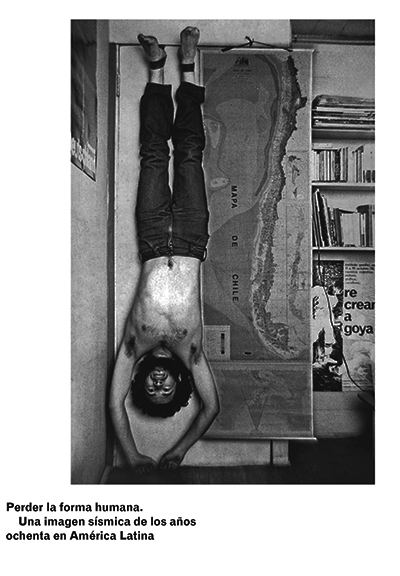In Terms of Performance (2016–)
Filed under book | Tags: · drama, glossary, performance, performance art, theatre

A keywords anthology designed to provoke discovery across artistic disciplines.
“In Terms of Performance is designed to generate shared literacies for how we understand the goals, skills, and artistic traditions of experimental interdisciplinary work. Over the past few years we have gathered essays and interviews from key artists, curators, presenters, and scholars whose work reflects on relations among visual art, theatrical, choreographic, and performance art practices. To seed the conversation, we created a list of keywords: common yet contested terms in our current context, when museums are incorporating ever more time-based art forms, theaters are commissioning visual art for their stages, and symposiums try to make sense of how this cross-pollination changes the nature of curating, collecting, producing, authoring, documenting, and commissioning. Some of these keywords are older terms that have been resuscitated and redefined; others have made an appearance only recently. Our goal was not to produce singular definitions nor to commission encyclopedic entries but to share perspectives from distinct locations.”
Terms: Act, Amateur, Character, Choreography, Collecting, Composition, Curating, Documentation, Duration, Ephemerality, Experience Economy, Improvisation, Installation, Live, Media, Narrative, Participation, Performativity, Postdramatic, Poststudio, Prop, Reenactment, Relational, Score, Site, Spectator, Theatricality, Virtuosity.
Edited by Shannon Jackson and Paula Marincola
Publisher Arts Research Center at University of California, Berkeley, and The Pew Center for Arts & Heritage, Philadelphia, 2016
Glossary of Common Knowledge (2017)
Filed under book | Tags: · art theory, commons, contemporary art, geopolitics, glossary, history, politics, subjectivation, subjectivity, theory

The Glossary of Common Knowledge is a research project by MG+MSUM, Ljubljana, in the frame of L’Internationale, aiming to negotiate various positions, contexts and local narratives about contemporary art. The glossary entries were produced through six seminars (2014-17), each focusing on one selected referential field: historicization, subjectivization, geo-politics, other institutionality, and commons. The resulting website now functions as an open platform accepting new contributions.
Fields and terms:
Historicization: archive, constellation, emancipation, temporally embodied sound, estrangement, heterochronia, humanism, intuition, pathological fracture, phantom (pain), reconstruction, self-historicization, temporalities, tendencies in art, the contemporary.
Subjectivization: creleasure, dancing as insurrectional practice, decolonize, evidence, fragility, interest, kapwa, loser, over-identification, radical imagination, self-determination, self-representation, on subjectivization, the subject, travesti, unrest.
Geo-politics: agitational visual language, alignment, catastrophe, eurasia, event, global resistance, institutional geopolitical strategies, migrancy, non-aligned movement, pandemic, postsocialism, south, tudigong, god of the land, white space.
Constituencies: agency, autonomy, biotope, bureaucratisation, collaboration / co-labour, construction, the continuity-form and counter-continuity, de-professionalization, intervenor, labour, ñande / ore, the eternal network / la fête permanente, the rest is missing.
Commons: to baffle, basic income, the brotherhood & unity highway, constituent power of the common, corrected slogan, data asymmetry , friendship, heterotopian homonymy, institution, noosphere, palimpsest, rog, self-management, solidarity, theft.
Other institutionality: a residual, adab, alternating, conspiratory institutions?, dark room, deviant, family, global crowd, interdependence, lobbying, reflexive / reflexivity, stultifera navis, the sustainable museum, the art hypothesis, translation.
Curated by Zdenka Badovinac, Bojana Piškur and Jesús Carrillo (MNCARS) in collaboration with L’Internationale, et al
Publisher MG+MSUM, Ljubljana, 2017
HTML (on the website of MG+MSUM)
HTML (on the website of L’Internationale, added on 2020-4-12)
Seminar recordings structured by terms discussed
Perder la forma humana: una imagen sísmica de los años ochenta en América Latina (2012) [Spanish]
Filed under book | Tags: · 1980s, activism, art history, glossary, latin america

“A glossary tends to be part of an annex appearing at the end of a publication. This book has inverted this logic and structured the entire publication around this tool. The publication is seen as a system that articulates – through relationships of affinity and contagion – a set of key concepts derived from both the lexicon of words and expressions coined by activists and artists during those years and from the anachronistic exercise of reframing these experiences in the light of the present. Each concept incites us to think about those practices, those ways of doing things in art and the politics of the experiences explored. The entries contain references to other categories in the glossary, in which the same experience or common practices can be approached from other perspectives. Furthermore, each entry is accompanied by abundant graphic material, photos and writings from the period, thus forming a profuse and polyphonic documentary base. These key concepts are intended to function as spearheads which, by traversing the material memory of these practices (documents and works of art) and also their immaterial memory (testimonies), give rise to new meanings.”
Published to accompany the exhibition Perder la forma humana [Losing the Human Form. A Seismic Image of the 1980s in Latin America].
“El proyecto editorial Perder la forma humana, ha sido concebido en articulación y diálogo con la propuesta expositiva de igual título. En este sentido, y a diferencia de un catálogo convencional, la publicación no restablece de manera enumerativa trabajos y prácticas presentes en la exposición, sino que se presenta como otro dispositivo (posible) de activación de esas prácticas en una reflexión sobre el presente.
Un glosario suele ser parte de un anexo que se incluye al final de una publicación. Este libro propone invertir esta lógica y estructurar toda la edición en torno a esta herramienta. Es así que la publicación se piensa como un sistema donde se articulan, en relaciones de afinidades y contagios, un conjunto de conceptos clave derivados tanto del léxico acuñado durante aquellos años por activistas y artistas como del ejercicio anacrónico de re-enmarcar estas experiencias a la luz del presente. Cada concepto constituye una entrada para pensar las prácticas, los modos de hacer arte y políticas de las experiencias investigadas. Las entradas contienen referencias a otras categorías del glosario, donde una misma experiencia o prácticas afines pueden ser enfocadas desde otras perspectivas. Por otro lado, cada entrada se completa con abundante material gráfico, fotos y escritos de época, formando una base documental profusa y polifónica. Estos conceptos clave aspiran, en definitiva, a funcionar como puntas de lanza que, al atravesar la memoria material (documentos y obras) e inmaterial (testimonios) de esas prácticas, propongan nuevas tramas de sentido.”
Edited by Red Conceptualismos del Sur
Publisher Museo Nacional Centro de Arte Reina Sofía, Madrid, 2012
ISBN 9788480264624
280 pages
Reviews: Juan Vicente Aliaga (Critique d’art 2012 FR), Horacio Ramos Cerna (Illapa 2013 ES).
Editors
Exhibition (EN)
Exhibition
Exhibition (Museo de Arte de Lima, Peru, 2014)
WorldCat
PDF, PDF (9 MB)
Portuguese trans. of Introduction

